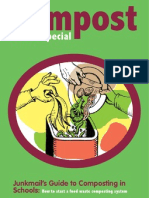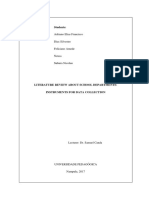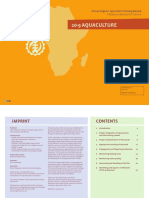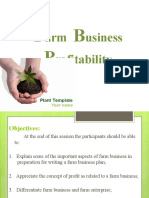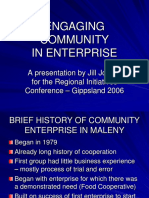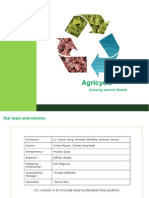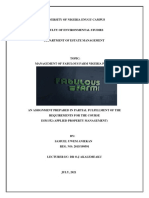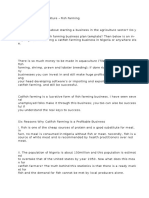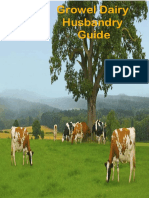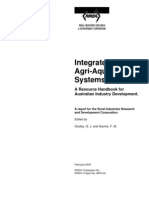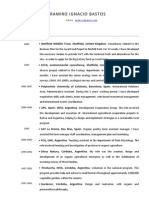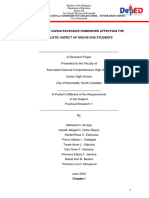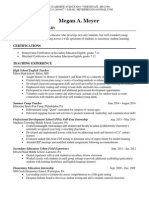Local Food Project Permaculture
Local Food Project Permaculture
Uploaded by
ramaxxCopyright:
Available Formats
Local Food Project Permaculture
Local Food Project Permaculture
Uploaded by
ramaxxOriginal Description:
Original Title
Copyright
Available Formats
Share this document
Did you find this document useful?
Is this content inappropriate?
Copyright:
Available Formats
Local Food Project Permaculture
Local Food Project Permaculture
Uploaded by
ramaxxCopyright:
Available Formats
Local food project
Business Plan Complementary Report
Consultant
Ramiro Bastos, Student Sheffield Hallam University
Local food project
Client
Sheffield Wildlife Trust 37 Stafford rd Sheffield S2 2SF Tel 0114 263 4335
Contact
Andy Wilmore, Environmental Regeneration Manager and Nigel West, Food and Health
Manager
Introduction
Sheffield Wildlife Trust is the citys largest environmental charity, working to promote conservation,
protection and improvement of the physical and natural environment of Sheffield. Targeted work to
protect vulnerable habitats and species is happening alongside initiatives to boost the general
wildlife value of parks and green spaces across Sheffield.
It was set up in 1985, and through the years the trust has been growing to develop activities in vast
areas:
Nature Reserves, managing several sites within Sheffield area, some of them with a SSSI
designation.
Urban Regeneration, focused in the creation of parks and open spaces and action as a link
between developers and communities.
Food initiatives, as the Food in Sheffield (5 A DAY) programme, promoting healthy eating in
Sheffield by working with local communities, community organisations, schools and the
retail and industry sectors.
Landscape, giving an extensive understanding of sustainable improvements to urban green
spaces: from large-scale recreation grounds, to local community gardens, from housing
development landscapes to the innovative use of the environment for children's play.
Recycling campaigns
Surveying, planning & policy making, collaborating in the Local Biodiversity Action Planning,
Park Users Forum, Sheffield First for Environment and other major plans for the city.
Education and training, working across Sheffield, Rotherham and Barnsley to engage
children and young people in environmental education and outdoor activities.
The Sheffield Wildlife Trust Local Food programme aims to create a space of managing land
sustainably for growing food locally based in Norfolk Park Estate, Sheffield. This project aims to
reinforce the Trusts work in supporting healthy eating and community regeneration, and will help
communities to improve health and well-being through access to high quality, locally grown food.
Other aspects of the project are the development of partnerships with local organisations, the
promotion of exercise in an open space site, the training of participants in a better understanding of
the natural cycles towards a sustainable management of land and a work plan with a view to
sustainability beyond initial grant funding.
Local food project
SWT will apply for a grant to the Local Food Programme from the Big Lottery Fund. Part of the
requirement of this application is a contribution to the Business Plan and a broad schedule of draft
work plan for the site.
Objectives
To research examples of similar projects existing around the country.
To carry out a wide market study base on potential costumers-users,
competitors, local markets, local networks, diversification alternatives.
Determine and contact potential Local Partners.
To research alternatives to the site and perform a SWOT of the aims and objectives of the
different components of project.
To design a broad schedule of draft work plan as a preliminary step of a management plan
for the site.
1.
Education/Training
Urban farming
Food andHealthy eating
6. Urban Farming
research
2. Health and
Wellbeing
Techniques and varieties
adapted to Sheffield
University /Colllege
involvement
Phisical
Mental
Product
/Service
Description
3. High Quality Veg
5. Seed Bank
Facilitate skils and
knowledge
Promote the site and the
park with innovative
approaches.
Conservation
Traditional varieties
4. Advice to
growers
Allotments
Gardeners
Local food project
The site
The proposed site is located within the boundaries of Norfolk Park, Sheffield, and 1 km east of the
city centre and bounded by Guilford Avenue in the south. The site forms an irregular rectangle of
approximately 4000 m2 (see fig 1). The ownership of the site is split on 2: Sheffield City Council owe
1/3 approx. on far east and Norfolk Park estate the rest.
The site has been used as a tree nursery in a community project managed by the trust, involving
community engagement activities in the period 2000-2005. After that, Green Estate (company
focused in regeneration programmes) used the site for a short period in an attempt to rescue the
trees growing on it. Currently the site is totally abandoned, in exception of a minor part used as
allotment by next door neighbours.
The access to the site is exceptionally easy, as the south entrance to the park is situated next to it
(see Fig. 1). There are excellent parking facilities 150 metres from the main entrance, as a cafe just 5
minutes walking. The entrance could present problems to people using wheelchair, fact that should
be addressed in the design.
All the edge and a subdivision more less in a third of the site is stonewall in relatively good condition,
in exception of a small segment in the far west that should be repaired. The smaller subdivisions are
hedges in good condition. There are rests of the trees still growing from the tree nursery. Some of
them could be donated to a tree-planting programme or to SCC Parks and Countryside.
There is no data related to the soil conditions. However, we could assume a good quality as it was
pre-conditioned for the former activities.
Figure 1 Aerial image of the proposed site, south view (Google Earth).
Local food project
5
Interviews
In order to target the objectives, some of the arranged activities were interviews. During the
consultancy there were three interviews. The first formal one was held in Firth Park with Gail
Griffith, Team Leader of Health Projects. In that meeting Gail commented on the relevant issues
related to successful experiences around community gardens. The key points were the garden as a
multispace /multiactivities, the connexion between health and gardening and the support of the
community and an experienced head gardener to ensure continuity.
The second formal meeting was held in Hagg Hill allotments with members of the Hagg Hill
association. The important topics in the conversation were the allotments as a source of food and
entertainment, the importance of socialising and sharing knowledge, the social diversity and the
Local food project
contact with nature. There were other important comments on technical details, e.g. size of the
allotments, lack of support from SCC, lack of experience as the main reason to quit and the costs of
tools and seeds.
The third informal meeting was held in Hangingwater allotments with a member of GrowSheffield
group. In that meeting the main comments were related to organic gardening, permaculture, seed
production and organisational aspects around organic agriculture in Sheffield.
Market research
As part of the required inputs from the client, an internet market research was performed. The main
constrain related to this activity was that most of the marketing reports are on sale as valuable
information for companies. Some interesting information was found in public organisation as DEFRA
or non-profit companies as Soils Association. All relevant the information was compiled in .pdf files
and attached in a CD.
Documents and guidelines
Other important issue of any project is the creation of a bibliographic bank. A large amount of
documents, handbooks and guidelines related to best practices and legislation has been collected
and organised. A copy of those documents could be found in the CD attached.
Dynamics of the consultancy
During the 10 weeks of the contract, several meeting were held in the offices of the trust and visits
to the site in a fortnight basis. There was constant and effective support from Andy Wilmore and
Nigel West during the whole period through meetings, phone calls and emails.
Project design
In order to produce alternatives to the use of the site, all the information collected from interviews,
marketing analysis and professional experience have been used. The use of architectural software as
AutoCAD and SketchUp supported the design phase to produce a digital 3D model of the site. A copy
of the files and a video of the model could be found in the CD attached.
Local food project
The alternatives
Vegetable
production
VEG PATCH
club
Grow vegetables and
entertainment
Alternative space to
socialise
Promote the site and the
park with innovative
approaches.
Commercial
potentialities
Ensure financial
sustainability
Therapeutic
Gardening
Phisical
Mental
Urban
Farming
Multispace
Urban farming
research
Ideal allotment
Allotments
Gardeners
Facilitate skils and
knowledge
University /Colllege
involvement
Traditional varieties
Sheffseed bank
Conservation
Techniques and
varieties adapted
to Sheffield
Local food project
Rear entrance
Shed +
Changing
Room
Ideal Organic
Allotment
Greenhous
e
Vegetable Garden +
Seed Bank + Research
project
VEG-PATCH
CLUB
Compost
area
Social area
Figure 2South view of the site project
view of the site project
Local food project
9
Figure 3 South view of the VEG-PATCH club
Primary Objective
To facilitate the knowledge, understanding and skills of individuals and groups in
vegetable gardening and its socioeconomic and environmental implications.
Secondary Objectives
To provide the training, equipment and physical space to develop individual
vegetable gardens on the site.
To encourage the partnership work with plot-neighbours, highlighting the
importance of co-operative effort.
To empower the users ownership of the site and its components, the park and the
Trust.
To develop knowledge and understanding of food quality, healthy diet and wellbeing.
To improve ecological awareness and wildlife conservation through different
techniques, such as organic farming and permaculture.
Overview
The VEGPATCH club is an association of individuals and groups interested in organic
vegetable gardening, lead by SWT. The association provides a single package with all the
tools and skills needed to start a vegetable garden within the site.
The package consists in:
An introductory course in organic vegetable gardening and the induction in the
regulations of the use and care of the site.
Local food project
Tenancy of one of the plots (VEGPATCH) which benefits of 25 m2 with 6 beds on it
of clean prepared land.
Compost bin.
A package of VEGPATCH starter seeds kit.
Access to water and tools shared with the rest of the users.
Advice and guidance will be offered in all the stages of the growing season by a
trained gardener in pre-arranged days of the week.
The first stage of the programme plans to create:
36 VEG PATCHS or plots (possible extension related to demand).
The amount of vegetables that a single VEG PATCH could produce has the
potentiality to save around 220 per year to the tenant (see Table 1).
Guidance cost of the service: 70/year as a membership, including the use of water,
a compost bin, a seed pack and introductory course in organic vegetable gardening
(this results on an income of 2520/year when all plots are taken, added to the
potential membership to the Trust). Discount OAPs, unemployed, disabled, SWT
members, cottage tenants will apply.
VEGPATCH starter kit: organic seeds (bought from local suppliers, eventually own
produced seeds from seed bank).
Possible extension to other 20 plots, depending on demand.
Sharing of tools (important social implications: co-operative effort, adaptation to
situation, shared ownership).
Table 1 Guide of potential production in a single VEG PATCH.
Vegetable
Yield (Kg)
Carrots
Lettuces
Broccoli
Onions + Leeks
Courgettes
Peas
Runner beans
Tomatoes
Garlic/Shallots
12.9
2.5
5.4
9
9
5.4
18
18
2.7
Annual Saving
Value in market (reference
Tesco, April 2008)
15.35 (1.19 /kg)
5.62 (2.25 /kg)
16.03 (2.97 /kg)
13.5 (1.5 /kg)
18 (2 /kg)
29.7 (5.5 /kg)
79 (4.4 /kg)
36 (1.99 /kg)
5.61 (2.1 /kg)
218.81
10
Local food project
11
SWOT analysis of VEG PATCH club
Internal Strengths
Internal Weaknesses
Historic work on the site on activities related
to gardening and plant production.
The proposal relies on trained and enthusiastic
staff.
Aims and objectives meet the priorities of
the local food project.
Loss of public interest on organic gardening
through failure to engage on attractive activities.
Based on a multispace approach, the
proposal has a strong emphasis on
economical sustainability.
Misuse of the site and problems of behaviour from
users (use of pesticides/fertilisers, negative
competition and disagreement between plot
neighbours).
Introduce an alternative space to socialise
and facilitate opportunities to develop
interpersonal skills.
Stratification on ages and sex or ethnical origin.
Organic approach ensures respect for wildlife
and natural resources and support the idea
of sustainable development.
External Opportunities
Sheffield is on top of the list of allotment
holders and the city with the biggest waiting
list (1400 in 2007).
Notorious publicity on vegetable gardening
on media (TV, radio, magazines).
Support of Sheffields strategy on sustainable
development.
The proposal will improve the image and
idea of the park as a place where you could
work and produce something.
There are 3 schools and dense
neighbourhood around the site.
Health and safety threats as the activities are
based on physical work and use of tools.
The idea of payment for the service could
generate tension from users.
External Threats
Vandalism is an important issue in the park and
surrounding areas.
Failure of previous projects on the site could
impact on the trust of the community.
Potential conflict with neighbours on noise.
Potential conflict with the rest of the users of
the park (parking, cafe, etc).
Local food project
12
Objectives
To build the spaces and equipment required to deliver a service focused in the use of
gardening as a therapeutic technique.
To deliver courses, activities and events related to gardening as a tool to combat social
isolation, enhancement of quality of life and well-being.
To highlight gardening in terms of physical activity as a method to prevent obesity and
other physical disorders.
To carry out training and awareness in healthy eating and well-being.
Overview
The proposal introduces a programme of activities focused of health and wellbeing. These activities
are related to the use of organic gardening as a therapeutic tool on people suffering obesity, mental
disorders and other difficulties.
The organic gardening on a communal allotment site is proven to create inclusionary spaces in which
people benefit in a mutually supportive environment that combats social isolation, enhancing the
quality of life and emotional well being (Milligan, C. et al, 2004).
Specially designed spaces will be built aiming to ensure users comfort and safety. The programme
will develop training on carers and other staff to ensure that health and safety issues are addressed
SWOT analysis of Therapeutic gardening module
Internal Strengths
Internal Weaknesses
- Extensive experience on food and health projects,
-Lack of infrastructure.
already managing a successful programme in the city.
- Dependent on trained staff.
-Main objective for the Trust.
- Health and safety threats as the activities are based on
physical work and use of tools.
External Opportunities
- Sheffield City Council is keen to incorporate new spaces
on the programme Growing Together (enables NHS
patients with mental difficulties to experience therapeutic
gardening).
-Extensive demand, especially related to activities to
tackle obessity and anti-social behaivour.
-Integration of patients with social activities.
External Threats
-Competition with similar facilities.
Local food project
13
Objectives
To recreate an allotment including the best practices in organic vegetable gardening in order
to use it as a training tool.
To deliver a service focused on courses and activities, and to provide advice to allotmenters
and gardeners, schools and general public.
To incorporate alternative activities to the site, such as engaging with the artistic community
in order to add aesthetical value to the plot (sculptures, graffiti, flower arrangements).
Overview
The allotment movement on Britain is nowadays vibrant and with a improved energy. Sheffield is on
top of the list on allotment holders (more than 3000) and on the waiting list (1400 people in 2007).
Most of the people taking allotments and trying to grow their own vegetables are new in organic
gardening and sometimes handle 300 m2 in an allotment could be overwhelming.
Therefore, the proposal addresses this issue with the creation of a space where allotmenters and
gardeners in general could benefit from training activities in an ideal organic allotment. This
conceptual site will be design to incorporate all the features and techniques of a organic allotment
(e.g compost area, greenhouse, shed, raised beds, etc). The primary aim is to use the site as a
educational tool.
SWOT analysis of the Ideal allotment module
Internal Strengths
-This activity addresses one of the main objectives of the
Local Food porject.
-The site presents the perfect infrastructure to provide an
ideal allotment.
-The activities in this plot could inspire the members of
the VEG PATCH club
Internal Weaknesses
-Requirement of trained staff with educatinal and
technical skils.
External Opportunities
-Vast demand on training from new allotments holders.
External Threats
- Vandalism is an important issue in the park and
-Potential arrangements with Parks and Countryside to
surrounding areas.
provide discounts to new allotment holders.
-Potential conflict with neighbours on noise.
Local food project
14
Objectives
To identify local varieties of vegetables grown by gardeners and allotmenters in the region.
To produce, collect, store and redistribute vegetable seeds of local varieties related to
certain criteria (weather, yield, flavour, facility to grow).
To facilitate training, activities and events in seed bank management and seed exchange.
To provide seeds to the VEG-PATCH club.
To develop the commercial opportunities of a Vegetable seeds starter kit, including selected
varieties and introductory information about organic gardening.
Overview
One of the proposed activities is the creation of a seed bank. This activity has the objective to
produce seeds in organic manner from local varieties, supporting the conservation and addressing
the needs for this kind of products. The area required to produce seeds is relatively small and the
site has the perfect conditions for it.
The final product of this activity is the development of a Starter Kit Package with the organic seeds
produced within the project and relevant information related to organic gardening. The potential
costumers are the members of the VEG PATCH club and general public.
SWOT analysis of the SHEFFSEED bank module
Internal Strengths
-Fulfil the conservational objective of the Local Food
porject and SWT in general.
-Support to the financial sustainability of the project.
-Relatively cheap tecnology.
-Small area required.
Internal Weaknesses
-Need of special training, as the techniques are
sometimes plant specific.
-Need to produce relatively large amount of seeds to
ensure the delivery of the products.
External Opportunities
-Potential engagement with conservation and
research groups.
-Fulfil the gap of the inmense demand of organic
seeds.
- Good marketing tool to engage the public with the
activities of SWT.
External Threats
-Competition with other producers.
-Legal constrains.
Local food project
Objectives
To research the different alternatives of urban farming adapted to local conditions.
To develop techniques of vegetable gardening in small spaces focused in people without the
access to an allotment or home garden.
To engage with universities and college in research activities related with urban farming and
sustainable development.
To publicise the findings in courses, magazines, journals and other media.
Overview
In order to engage with the university community and to fulfil the growing demand on organic
gardening and permaculture techniques, the project pretends to create a programme of urban
farming research. The aim is to generate significant contributions to the knowledge on vegetable
growing in small spaces, as householder gardens or pots in a local basis. Proposals of dissertations,
thesis and research on nature conservation related to urban farming will be supported.
SWOT analysis of the Urban farming research module
Internal Strengths
Internal Weaknesses
-No need of special infrastructure or training.
- It could produce tension between research teams.
-It could create of a vibrant and dynamic atmosphere
- Potential lack of continuity.
in the site.
External Opportunities
External Threats
-Current good relationship with University of
-Potential lack of interest from the university
Sheffield and Sheffield Hallam University.
community.
-Good publicity, linking the activities with the creation
of knowledge.
15
Local food project
Vegetable production
16
Objectives
To produce organic vegetables in a semi-commercial scale.
To create partnership with the parks cafe, schools and other potential customers to ensure
a constant demand.
To implement a management plan for the site dedicated to low energy maintenance.
Overview
As a complementary activity, the site design proposed will create a space to produce organic
vegetables. Interest has been shown from the parks cafe owner and several schools in the area. The
demand of this kind of products is inmense in the city. Other potential customers are organic
vegetable shops, vegetarian restorants and other local food networks. The gardener will be in charge
of the production as a secondary activity.
SWOT analysis of the Vegetable production module
Internal Strengths
-The plots could help to inspire and to be used as a
training tool from the members of the VEG PATCH
club and general public.
-The plots could be used as seed production and
research, linking with the rest of the activities on the
site.
-Support financial sustainability.
Internal Weaknesses
- The proposal relies on trained and enthusiastic staff.
-Need to produce relatively large and sustained amount
of vegetables.
External Opportunities
-Strong links with local schools and other potential
customers.
-Extensive demand of organic vegetables.
- Good marketing tool to engage the public with the
activities of SWT.
External Threats
-Vandalism is an important issue in the park and
surrounding areas.
-Competition and legal constrains.
You might also like
- Sfa Scool Function AssementDocument18 pagesSfa Scool Function AssementAnielle OliveiraNo ratings yet
- Printable Iq Test With Answers PDFDocument2 pagesPrintable Iq Test With Answers PDFBiniam Nega31% (13)
- Greenwich Forest Garden: at Hampshire CollegeDocument21 pagesGreenwich Forest Garden: at Hampshire CollegeΡομίρ Γιάνκκιλ100% (1)
- Ridan Composter School Food Waste Recycling Composting Food Waste SpecialDocument23 pagesRidan Composter School Food Waste Recycling Composting Food Waste Specialapi-203782732No ratings yet
- Crop GeometryDocument5 pagesCrop Geometryag_gill87100% (1)
- School Functional AreasDocument3 pagesSchool Functional AreasJoão Bandeira De Melo Papelo0% (1)
- Incredible Edible Somerset Permaculture DesignDocument19 pagesIncredible Edible Somerset Permaculture DesignNicoleEmptyCagesNo ratings yet
- Rhubarb Business Plan v2 1Document15 pagesRhubarb Business Plan v2 1Tawatchai LimmontholNo ratings yet
- Beekeeping Regional Situational-AnalysisDocument115 pagesBeekeeping Regional Situational-Analysissid101rajNo ratings yet
- African Organic Agriculture Training ManualDocument25 pagesAfrican Organic Agriculture Training Manualfshirani7619No ratings yet
- Duck RaisingDocument14 pagesDuck RaisingJoraxNo ratings yet
- Advanced Beekeeping Manual - EnglishDocument76 pagesAdvanced Beekeeping Manual - EnglishEngr. Md Shaikat RaihanNo ratings yet
- Session 3 - Farm Business ProfitabilityDocument22 pagesSession 3 - Farm Business ProfitabilityAries TibarNo ratings yet
- How To Start Different Animal FarmingDocument44 pagesHow To Start Different Animal FarmingOpirexNo ratings yet
- Use Rabbit Urine To Repel Pests - Daily MonitorDocument13 pagesUse Rabbit Urine To Repel Pests - Daily Monitoraquamariaxtine5914No ratings yet
- Guide For Spinach ProductionDocument19 pagesGuide For Spinach ProductionAnonymous H1tVk4No ratings yet
- Community Enterprise Jill JordanDocument12 pagesCommunity Enterprise Jill Jordanpeoplesgeography8562No ratings yet
- Atlanta Agritecture Workshop Team 3Document18 pagesAtlanta Agritecture Workshop Team 3hgordonsmithNo ratings yet
- Assn6 PDFDocument2 pagesAssn6 PDFElzNo ratings yet
- Beekeeping Biz Plan 16Document3 pagesBeekeeping Biz Plan 16Josephine Chirwa100% (1)
- Sustainable Agricultural PracticesDocument11 pagesSustainable Agricultural PracticesVeverley CarupoNo ratings yet
- Management of Fabulous Farm Nigeria PropertyDocument17 pagesManagement of Fabulous Farm Nigeria PropertyUwem SamuelNo ratings yet
- Springberry Farm PlanDocument9 pagesSpringberry Farm PlanTravis Cooper100% (2)
- GPSNP Final Esmf 24 04 18Document135 pagesGPSNP Final Esmf 24 04 18ANIKET BABUTANo ratings yet
- Business Plan PURBA FARM PDFDocument18 pagesBusiness Plan PURBA FARM PDFArdyanthaSivadaberthPurba100% (1)
- Clifton Farm Business PlanDocument11 pagesClifton Farm Business PlanUBUNTU SHOPNo ratings yet
- Kaithi Beekeeping ProjectDocument5 pagesKaithi Beekeeping ProjectPrasanna GopalrathinamNo ratings yet
- Of Vertical Farming (Indoor) Over Traditional Farming (Outdoor)Document30 pagesOf Vertical Farming (Indoor) Over Traditional Farming (Outdoor)Sneha Periwal100% (1)
- 4th RUFORUM Biennial Conference Programme Book Web - FinalDocument98 pages4th RUFORUM Biennial Conference Programme Book Web - Final071975_mlv100% (1)
- Year Round FodderDocument5 pagesYear Round FodderLalit PatilNo ratings yet
- Fish FarmDocument10 pagesFish FarmSamuel FanijoNo ratings yet
- Little Bag SilageDocument5 pagesLittle Bag SilagelrvcsNo ratings yet
- 1Document6 pages1Rajdeep RajdipNo ratings yet
- CFAK-Girl Power Project ProposalDocument21 pagesCFAK-Girl Power Project ProposalAyuba Daniel La'ah100% (1)
- Growel Dairy Husbandry GuideDocument13 pagesGrowel Dairy Husbandry GuideGrowel Agrovet Private Limited.No ratings yet
- Anscie Beef CatleDocument81 pagesAnscie Beef CatleJalaine Montezo EbenNo ratings yet
- 3DVF Dairy Farm in The PhilippinesDocument30 pages3DVF Dairy Farm in The Philippinescarrmie100% (1)
- MVO Factsheet SkygreensDocument2 pagesMVO Factsheet SkygreensSiyad SiddiqueNo ratings yet
- SYNTROPIC AGROFORESTRY SECRETS FOR LAND OWNERS BOOKLET v2Document20 pagesSYNTROPIC AGROFORESTRY SECRETS FOR LAND OWNERS BOOKLET v2SeTiAlYa100% (1)
- Azolla Cultivation Guide Rich Proteins Feed For Cattle Poultry Fish and PigDocument5 pagesAzolla Cultivation Guide Rich Proteins Feed For Cattle Poultry Fish and PigamarNo ratings yet
- Plant NurseryDocument9 pagesPlant NurserySonya FlowersNo ratings yet
- Agri AquacultureDocument189 pagesAgri AquaculturebbdddNo ratings yet
- Larvae 3Document81 pagesLarvae 3Kenaia AdeleyeNo ratings yet
- Erbs Medical For RabbitDocument13 pagesErbs Medical For RabbitkevesoNo ratings yet
- Production BusinessesDocument32 pagesProduction BusinessesGanesh ShresthaNo ratings yet
- Fully Automatic Hydroponics Fodder Machine 160kg CapacityDocument10 pagesFully Automatic Hydroponics Fodder Machine 160kg CapacitygurvinderNo ratings yet
- Zambia The Community School Based Urban Agriculture Project of Project Concern International - LusakaDocument6 pagesZambia The Community School Based Urban Agriculture Project of Project Concern International - LusakaFree Rain Garden ManualsNo ratings yet
- An Experience of Hydroponics Fodder Production by Farmers of Bagalkot DistrictDocument4 pagesAn Experience of Hydroponics Fodder Production by Farmers of Bagalkot DistrictOnur SeferNo ratings yet
- PitahayaDocument11 pagesPitahayajorgeNo ratings yet
- Urban PermacultureDocument43 pagesUrban Permacultureapi-252298332No ratings yet
- Wood Vinegar Mokusaku': Proven Effects of Wood Vinegar To Benguet Local FarmersDocument2 pagesWood Vinegar Mokusaku': Proven Effects of Wood Vinegar To Benguet Local FarmersjeffreyNo ratings yet
- A History of Heinz Tomato KetchupDocument2 pagesA History of Heinz Tomato KetchupKamran HassanNo ratings yet
- Climate-Smart Agriculture Source BookDocument570 pagesClimate-Smart Agriculture Source BookZakaria El Houbi100% (1)
- School - Community Garden ResourcesDocument12 pagesSchool - Community Garden Resourcescalderdavid35No ratings yet
- Fodder & LivestockDocument15 pagesFodder & Livestockskmdec09No ratings yet
- Introduction - Future FarmerDocument3 pagesIntroduction - Future Farmerfuture farmers100% (1)
- Enhancing Sustainability of Dry Land Rainfed Farming SystemsDocument16 pagesEnhancing Sustainability of Dry Land Rainfed Farming SystemsmsharathsNo ratings yet
- Organic and Inorganic PesticidesDocument25 pagesOrganic and Inorganic Pesticidesmomiii.2410No ratings yet
- Pineapple: Organic Farming in The Tropics and SubtropicsDocument36 pagesPineapple: Organic Farming in The Tropics and SubtropicsHolger KahlNo ratings yet
- Organic Production of Coffee, Okra, Tomato, Mango and BananaFrom EverandOrganic Production of Coffee, Okra, Tomato, Mango and BananaRating: 3 out of 5 stars3/5 (1)
- The State of World Fisheries and Aquaculture (Sofia)From EverandThe State of World Fisheries and Aquaculture (Sofia)No ratings yet
- proposal on establishing community gardeDocument3 pagesproposal on establishing community gardehagushk1009No ratings yet
- Transition StepsDocument1 pageTransition StepsramaxxNo ratings yet
- ROCKCOTE Natural Materials BookDocument32 pagesROCKCOTE Natural Materials Bookramaxx100% (1)
- CV Ramiro BastosDocument2 pagesCV Ramiro BastosramaxxNo ratings yet
- CV Ramiro BastosDocument1 pageCV Ramiro BastosramaxxNo ratings yet
- A. AG Holder's Characteristics: 1. 0 To 15 Years OldDocument5 pagesA. AG Holder's Characteristics: 1. 0 To 15 Years OldramaxxNo ratings yet
- Sheffield Hallam UniversityDocument12 pagesSheffield Hallam UniversityramaxxNo ratings yet
- My Learning Episode OverviewDocument39 pagesMy Learning Episode OverviewHermann Dejero LozanoNo ratings yet
- Academic Schedule 2014 ODDDocument2 pagesAcademic Schedule 2014 ODDKiran ThekedarNo ratings yet
- Course-501 Elementary Education in India: A Socio-Cultural Perspective Ikb Øe&501 HKKJR Esa Izkjafhkd F'K (KK%, D Lkekftd Lkalñfrd Ifjizs (Document3 pagesCourse-501 Elementary Education in India: A Socio-Cultural Perspective Ikb Øe&501 HKKJR Esa Izkjafhkd F'K (KK%, D Lkekftd Lkalñfrd Ifjizs (RamNo ratings yet
- Artefact 1 - Lesson PlanDocument5 pagesArtefact 1 - Lesson Planapi-286403191No ratings yet
- Eduu 510 Course at A GlanceDocument3 pagesEduu 510 Course at A Glanceapi-268700252No ratings yet
- Resume Daniel SpauldingDocument2 pagesResume Daniel Spauldingapi-264370674No ratings yet
- KTK OC 2 Project SES Report 2022-23Document178 pagesKTK OC 2 Project SES Report 2022-23festivista.cessNo ratings yet
- Assignment: Name Priya.P CANDIDATE CODE:13375009Document22 pagesAssignment: Name Priya.P CANDIDATE CODE:13375009galaxycafeforuNo ratings yet
- Basic Research TemplateDocument4 pagesBasic Research TemplateChristopher Dela Cruz EsperoNo ratings yet
- Descriptive ResearchDocument18 pagesDescriptive ResearchDeep Arora100% (3)
- Emerging Practices Artifact 2 - ProcessfolioDocument2 pagesEmerging Practices Artifact 2 - Processfolioapi-266155292No ratings yet
- Christian Reed's Teaching ResumeDocument1 pageChristian Reed's Teaching ResumeChristianSReedNo ratings yet
- Kindergarten Cambridge Bocu Mihali Camelia AlinaDocument3 pagesKindergarten Cambridge Bocu Mihali Camelia AlinaCarmen Delia BocuNo ratings yet
- TestingDocument15 pagesTestingAldrinBalitaNo ratings yet
- Chapter1 Group5 ABM4Document12 pagesChapter1 Group5 ABM4Prince Adrian GalagateNo ratings yet
- Resume WebsiteDocument2 pagesResume Websiteapi-319860340No ratings yet
- Sydney End of Year ReportDocument2 pagesSydney End of Year Reportapi-152325209No ratings yet
- Guidance Reflection PaperDocument3 pagesGuidance Reflection Paperapi-386041937No ratings yet
- Asgl School CompactDocument3 pagesAsgl School Compactapi-222875754No ratings yet
- Instructional LeadershipDocument3 pagesInstructional LeadershipMohd Zaki Mohamed SomNo ratings yet
- Pre-Observation FormDocument2 pagesPre-Observation Formapi-354685236No ratings yet
- Professional ResumeDocument2 pagesProfessional ResumeJessie BurnsNo ratings yet
- Resume-Megan MeyerDocument2 pagesResume-Megan Meyerapi-248877226No ratings yet
- Intel Teach Brochure GlobalDocument4 pagesIntel Teach Brochure Globalapi-296687850No ratings yet
- Qualitative ResearchDocument14 pagesQualitative Researchhayleymeredith67% (3)
- CT 121 SyllabusDocument9 pagesCT 121 SyllabusJonathan Delos Santos100% (1)
- Test Item For Prof Ed Course 6aDocument5 pagesTest Item For Prof Ed Course 6aMa Christina EncinasNo ratings yet



